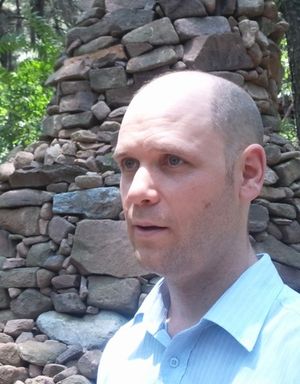We go to the Kansong Art Museum Daegu. I am following Lisa around looking at the paintings. The room is dark, and the paintings are tastefully lit from above. I don't have my glasses on, so lean in close to admire the detail in the 500 year old paintings. And I mash my nose into the glass.
Lisa looks up when she hears the bonk.
"Daddy. What's wrong?"
"The glass was too clear, I didn't see it."
"Well," she says, "It isn't so clear now."
Two smudged circles, the impression of my nose, float in the middle of the otherwise spotless glass. I pull my sleeve over the heel of my hand to rub it clean, but Lisa suggests I should just leave it. I agree that she is probably right, and we move on.
Korea has lots of Museums that are nationally or regionally funded and cheap or free to the public. Some are better than others, but most are worth a visit.
The Daegu Art Museum, out by the Daegu World Cup Stadium, is certainly worth a visit. Like many Art Museums, it caters to a mix of tastes, and for me it has its hits and misses. We go there at least once a year, as they are always rotating exhibitions of contemporary art, mostly Korean, but also featuring some international artists.
Today, for the first time, we went to the Kansong Art Museum, which is just a minute's walk from the Daegu Art Museum, but in a separate building.
It has a different remit. It is a museum of historical art.
The pseudnymous Kansong is known for collecting and restoring great works of historic Korean art that had been misplaced during the Japanese occupation of Korea. His is a long story, but the result is an extensive collection of classical art that might have otherwise been lost.
The Kansong Museum in Daegu is not the only Kansong Museum, and does not have many of the pieces from the Kansong collection, indeed; it only has very few, but those that it has are exceptional. This is part of what makes this Museum stand out for me. The focus is not on showing you every example of traditional art, but showing you a select sample of the very best.
It seems that Kansong himself had strong opinions on art and its presentation, and whoever is running this Museum has similar sensibilities. I don't think I've ever seen a museum that left me so impressed by the historical Korean artists.
It isn't just the art. The building itself is an exhibit. The exhibits are thoughtfully set in dark galleries, and lit from above to remove distraction. In the foyers between the different exhibits, there are computerised signboards with tallies of the number of people currently in each exhibit, so that you can choose the more empty exhibits. And last but not least, the English translations are not only good translations, they are as artful as the exhibits, done by someone who is an exceptional writer.
Many good museums, in Korean (and other countries too), suffer from ham-fisted translations. They often fail to properly translate even the most basic details of the works, let alone any of the contextual analysis. I often think it would be better to have no translation, as a poor translation leaves one with the impression that the original language descriptions are similarly nonsensical. It leaves one not only unsure of what one has seen, but also thoroughly unimpressed with the thought put into the exhibition.
Apart from its somewhat awkward name, the Kansong Art Museum Daegu is an example of how well thought out a museum can be. It is not free, costing 6000 won per adult (with a %30 discount if you bring evidence that you live in Daegu). It is not a huge Museum, but you can easily spend two hours there, reading the wonderful descriptions.
We are looking at the restoration room. It is empty now, but during the week, a couple hours a day, you can watch someone there restoring art, and apparently, can ask them questions.
Eunjoo comes up and asks us what it is.
"Restoration room," I say. Everything is, of course, written in Korean too, but my wife has never had the patience for reading things– subtitles, instructions, recipes, the letters I sent her when we were long distance dating in the late '90s.
I point to the microphone you can use to ask the restorer questions. "When there is someone in there, you can give them orders with that, and they do anything you say. It's how most of the art in this museum is done."
She seems about to accept this, when Lisa shakes her head and rolls her eyes.
"What are they looking at?" she asks, pointing across the foyer.
I look to where she is pointing, but she realises before I do that is it just a reflection of us.
"You thought it looked interesting, eh?" I say smiling.
"Yeah," she laughs. "They seemed really engaged."
"It it looked like he was out of his league." I say.
She laughs, but I don't think she understands what I said.

